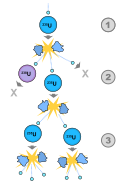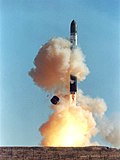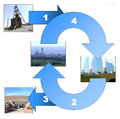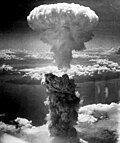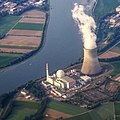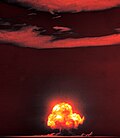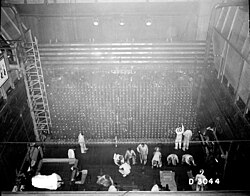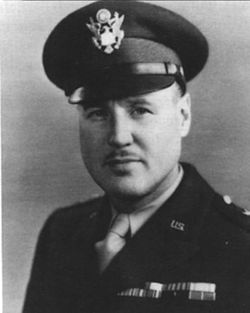Portal:Nuclear technology
The Nuclear Technology Portal
Introduction

- Nuclear technology is technology that involves the nuclear reactions of atomic nuclei. Among the notable nuclear technologies are nuclear reactors, nuclear medicine and nuclear weapons. It is also used, among other things, in smoke detectors and gun sights. (Full article...)
- Nuclear power is the use of nuclear reactions to produce electricity. Nuclear power can be obtained from nuclear fission, nuclear decay and nuclear fusion reactions. Presently, the vast majority of electricity from nuclear power is produced by nuclear fission of uranium and plutonium in nuclear power plants. Nuclear decay processes are used in niche applications such as radioisotope thermoelectric generators in some space probes such as Voyager 2. Reactors producing controlled fusion power have been operated since 1958 but have yet to generate net power and are not expected to be commercially available in the near future. (Full article...)
- A nuclear weapon is an explosive device that derives its destructive force from nuclear reactions, either fission (fission or atomic bomb) or a combination of fission and fusion reactions (thermonuclear weapon), producing a nuclear explosion. Both bomb types release large quantities of energy from relatively small amounts of matter. (Full article...)
General images -
Selected article -
During the Cold War, the project expanded to include nine nuclear reactors and five large plutonium processing complexes, which produced plutonium for most of the more than 60,000 weapons built for the U.S. nuclear arsenal. Nuclear technology developed rapidly during this period, and Hanford scientists produced major technological achievements. The town of Richland, established by the Manhattan Project, became self-governing in 1958, and residents were able to purchase their properties. After sufficient plutonium had been produced, the production reactors were shut down between 1964 and 1971.
Many early safety procedures and waste disposal practices were inadequate, resulting in the release of significant amounts of radioactive materials into the air and the Columbia River, resulting in higher rates of cancer in the surrounding area. The Hanford Site became the focus of the nation's largest environmental cleanup. A citizen-led Hanford Advisory Board provides recommendations from community stakeholders, including local and state governments, regional environmental organizations, business interests, and Native American tribes. Cleanup activity was still ongoing in 2023, with over 10,000 workers employed on cleanup activities.
Hanford hosts a commercial nuclear power plant, the Columbia Generating Station, and various centers for scientific research and development, such as the Pacific Northwest National Laboratory, the Fast Flux Test Facility and the LIGO Hanford Observatory. In 2015, it was designated as part of the Manhattan Project National Historical Park. Tourists can visit the site and B Reactor. (Full article...)
Selected picture -
Did you know?
- ... that before becoming a successful children's author, Myron Levoy was an engineer doing research on nuclear-powered spaceships for a mission to Mars?
- ... that after a 2008 tornado, Michael Chertoff likened Picher, Oklahoma, to a nuclear bomb site?
- ... that campaigning by climate activist Kimiko Hirata halted plans to build 17 new coal-fired power plants following the Fukushima nuclear disaster in Japan?
- ... that the Manhattan Project feed materials program used uranium ore from a mine in Canada near the Arctic Circle?
- ... that Fritz Strassmann, a co-discoverer of nuclear fission, concealed a Jewish woman in his home during World War II?
- ... that the area of Cultybraggan Camp has been a royal hunting ground, a prison for fervent Nazis and the site of an underground bunker intended for use in a nuclear war?
Related WikiProjects
Things you can do
Selected biography -
|29 =
Kenneth David Nichols CBE (13 November 1907 – 21 February 2000) was an officer in the United States Army, and a civil engineer who worked on the secret Manhattan Project, which developed the atomic bomb during World War II. He served as Deputy District Engineer to James C. Marshall, and from 13 August 1943 as the District Engineer of the Manhattan Engineer District. Nichols led both the uranium production facility at the Clinton Engineer Works at Oak Ridge, Tennessee, and the plutonium production facility at Hanford Engineer Works in Washington state.Nichols remained with the Manhattan Project after the war until it was taken over by the Atomic Energy Commission in 1947. He was the military liaison officer with the Atomic Energy Commission from 1946 to 1947. After briefly teaching at the United States Military Academy at West Point, he was promoted to major general and became chief of the Armed Forces Special Weapons Project, responsible for the military aspects of atomic weapons, including logistics, handling and training. He was deputy director for the Atomic Energy Matters, Plans and Operations Division of the Army's general staff, and was the senior Army member of the military liaison committee that worked with the Atomic Energy Commission.
In 1950, General Nichols became deputy director of the Guided Missiles Division of the Department of Defense. He was appointed chief of research and development when it was reorganized in 1952. In 1953, he became the general manager of the Atomic Energy Commission, where he promoted the construction of nuclear power plants. He played a key role in the security clearance hearing against J. Robert Oppenheimer that resulted in Oppenheimer's security clearance being revoked. In later life, Nichols became an engineering consultant on private nuclear power plants. (Full article...)
Nuclear technology news
No recent news
Related portals
Related topics
Subcategories
Associated Wikimedia
The following Wikimedia Foundation sister projects provide more on this subject:
-
 Commons
Commons
Free media repository -
 Wikibooks
Wikibooks
Free textbooks and manuals -
 Wikidata
Wikidata
Free knowledge base -
 Wikinews
Wikinews
Free-content news -
 Wikiquote
Wikiquote
Collection of quotations -
 Wikisource
Wikisource
Free-content library -
 Wikiversity
Wikiversity
Free learning tools -
 Wiktionary
Wiktionary
Dictionary and thesaurus
-

-

-

-

-
Random portal



















